- TOP
- Search Criteria
- Be Moved by the magnificent view of Mount Fuji! Mt. Fuji World Heritage Centre in Shizuoka Prefecture

STORY
Be Moved by the magnificent view of Mount Fuji! Mt. Fuji World Heritage Centre in Shizuoka Prefecture
- SHIZUOKA
- Mt.FUJI
- FUJISAN
- SIGHTSEEING
- SPECIAL
- UNESCO
- WORLD_HERITAGE
- MUSEUM
- SOUVENIRS
- JAPANESE_SOUVENIRS
- MOUNT_FUJI
- PHOTOGENIC
- ART
The Mt. Fuji World Heritage Centre in Shizuoka Prefecture introduces you to the highest mountain in Japan, Mount Fuji. Recently opened in December 2017, this facility will show you the charm and value that Mount Fuji has for Japan. In 2013 Mount Fuji was registered as UNESCO World Heritage Site so be sure to take a lot of pictures from the observation deck!
The exterior is uniquely shaped to resemble Mt. Fuji but upside down. Directly in front is a shallow pond filled with spring water from the mountain. The reflection of the building in the still waters sets the elegant tone that Mt. Fuji offers.

Try to visit on a clear sunny morning and you will be able to see the real Fuji together with the building.
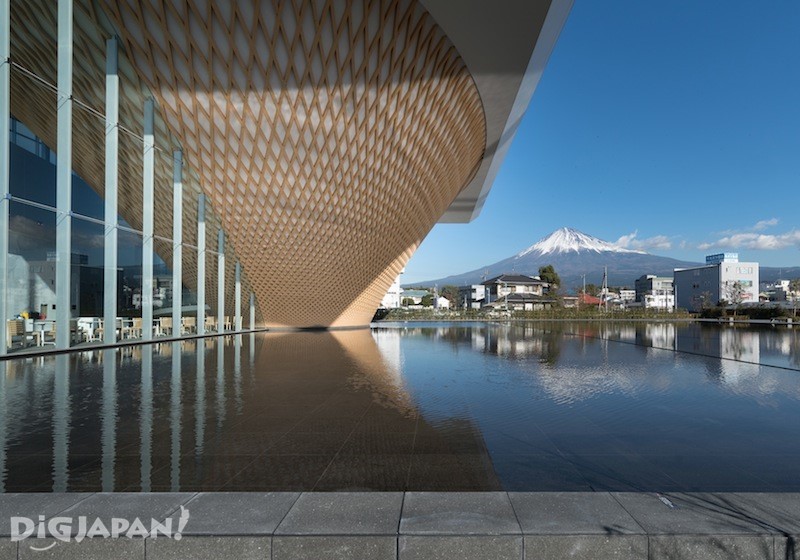
In the atrium you can see the peculiar structure up close.

The wall of the structure is made up of almost 8,000 pieces of Fuji Hinoki, a Japanese cypress that grows at the foot of Mt. Fuji.
The pieces of cypress have been braided in a basket weave. They achieved this by the cutting the surface of the wood to give it a soft curved shape. I touched it and it was super smooth.

This way you can enjoy the scenery from the base of the mountain all the way to the summit.
The top floor features an observatory for an even better view. Have a seat on the "Upside-down Fuji Bench" and admire Mt Fuji like a painting from this hall.

Continuing on you will find the outdoor terrace. On a day with good weather the glass doors are opened. Surrounding the terrace are brown rugged stones. These stones are made up of lava from one of Mt. Fuji's eruptions.


This exhibit features the painting Fuji Mandala Zu. Here the religious aspects of Mt. Fuji are explained. At the top of My. Fuji is a crater called Ohachi. This crater is made up of several peaks, such as Kengamine, the tallest one. Since ancient times it is believed that Buddha appears on these peaks.
One particular exhibit focuses entirely on the shape of Mt. Fuji. The broad base wrapped with white snow has a great influence on Japanese literature and art. Large screens project paintings in their original scale.
This area shows how the rain and snow falling on Mt. Fuji become spring water. It is very fascinating to see how this process works.

While it is loved as an object of faith and art, Mt. Fuji is still an active volcano. Here you can see its many layers and the effects of the eruptions. The walls and floors were created by Mr. Shuhei Hasado, a plaster craftsman. He used ancient methods that are used for Japanese houses.

Here you can leave your own personal message on a card shaped like Mt. Fuji. Have fun looking for your message the next time you visit.

Out on the terrace you will find a Fujizuka.

A Fujizuka is typically a small pile of stones or a mound that represents Mt. Fuji. At the top of it is a shrine. These surrogates were made for pilgrims who were unable to climb the mountain. If you're not confident about climbing the real Mt. Fuji you can climb this Fujizuka instead.
The facility also has temporary exhibits, occasionally featuring paintings of Mt. Fuji and even some works that are considered national treasures. Also, at the theater is a huge 265-inch large screen (approx.. 6.7 meters). They showcase the nature of culture of Mt. Fuji in 4k high-definition. The runtime is about 7 minutes and it's shown 4 times an hour.

The advisor of the museum shop is Riyo Mori, a Shizuoka native who was Miss Universe in 2007. She also designs original goods.

If you eat at the café, my food recommendation is this juicy hotdog made from Yoguru pork topped with a green tea sauce. Yoguru pigs are bred at the foot of Mt. Fuji. This is a specialty of Shizuoka and has a rich and tasty flavor.

There are also the lava ice cream (378 yen) which is ice cream sandwiched in a bun that looks like a lava stone, and Mt. Fuji-inspired soft cream (399 yen).
Address: 5-12, Miya-cho, Fujinomiya-shi, Shizuoka
Hours: 9:00am - 5:00pm (6:00pm in July and August) *Entrance available until 30 minutes before closure
Closed on every third Tuesday of the month and on facility inspection days
Entrance fee: Permanent exhibit 300 yen, free for students and people 70 years or older. The fee for the temporary exhibit varies depending on the exhibit
Access: 8 min. walk from Fujiomiya Station on the JR Minobu Line. For people arriving to Shin-Fuji Station with the Tokaido Shinkansen: take the high speed bus bound for Fujisan Station and get of at the Mt. Fuji World Heritage Centre stop (36 min. bus ride).
*The high speed bus doesn't run on weekends, from December 29 to January 3, and from August 13 to 16. In those days there is also the bus bound for Kyukamura Fuji.
Website: https://mtfuji-whc.jp/en/

Located about 3 minutes on foot from the centre, this shrine has a history of over 2,000 years.

In front of the romon (tower gate) is a path called Sakura-no-baba, where the annual yabusame festival is held on May 4-6. Yabusame is a traditional Japanese mounted archery where you shoot a target with a bow and arrow while riding a running horse. In the grounds there is a statue of a man practicing yabusame.

Walking through the tower gate you enter the shrine grounds. The main shrine was designated as an Important Cultural Property of Japan. By the way, the Mt. Fuji World Heritage Center was built at a lower height than the main shrine so as not to look down on God.

There is a volcanic bomb, a mass of molten rock that was ejected from Mt. Fuji during an eruption on display in the shrine. You will also find a stone from the South Pole on display as well. Both are very rare and unusual.
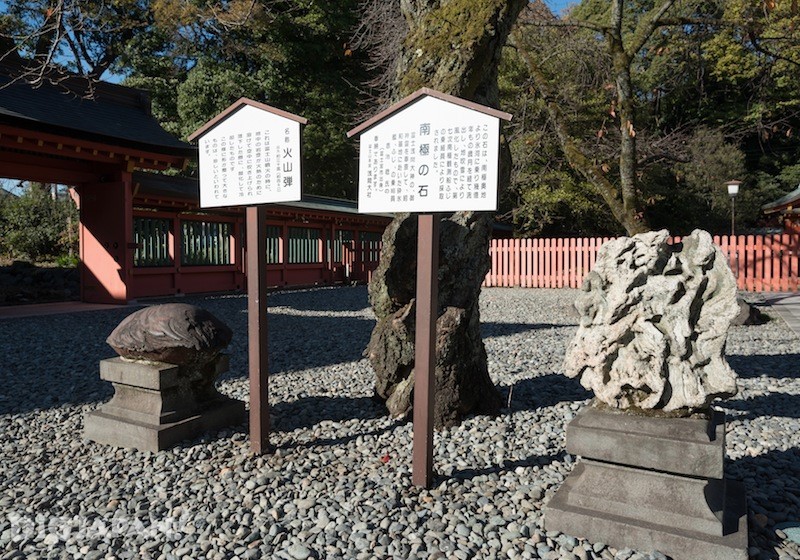
Towards the back of the grounds is the Wakutama-ike pond. The natural spring water is crystal clear giving a beautiful reflection. You can even see the aquatic plant life and the fish swimming in the pond.

In the past, climbers of Mt. Fuji would cleanse their body in the pond's spring waters. All year round the temperature of the water is 13℃. If you touch the water of the pond it will feel cold in the summer and warm in the winter.
Right next to the pond is Mizuya Shrine. Here you can drink the spring water and even bring some home in a container.

Address: 1-1 Miya-cho, Fujinomiya-shi, Shizuoka
Hours: 6:00am - 7:00pm from November to February / 5:30am - 7:30pm from March to October / 5:00am - 8:00pm from April to September
Access: 10 min. walk from Fujiomiya Station on the JR Minobu Line
Website: http://fuji-hongu.or.jp/sengen/english/index.html

My attention was caught by a shop called Musubiya so I tried their Fujinomiya yakisoba. You can choose a topping of seaweed and fried eggs shaped like Mt. Fuji. You can also choose between two flavors: shio, a salt spice, and noodle sauce. I had to take a picture before eating!

The dish in the picture is called Fujiyama and it's 650 yen. 500 yen without the topping.
Musubiya also sells dango (sweet rice dumplings) and rice balls. The staff highly recommended the dumplings, saying that they are made with spring water from Mt. Fuji so I tried those as well.

The seasoning on the Fujinomiya yakisoba is original for each shop. It's fun to order a few from different places and compare.
In Omiya Yokocho there is a fountain with spring water from Mt. Fuji. You can get a paper cup at the shops and enjoy a drink. The water has a clean, natural taste. Very refreshing.

When your stomach is full, it's time to go shopping for souvenirs at Kitagawa. The most popular items in this store are calligraphy cards along with "Mini Fuji", statues made up of sand from Mt. Fuji.

You can ask the staff what's written on the cards. They are sold for 500 yen each.
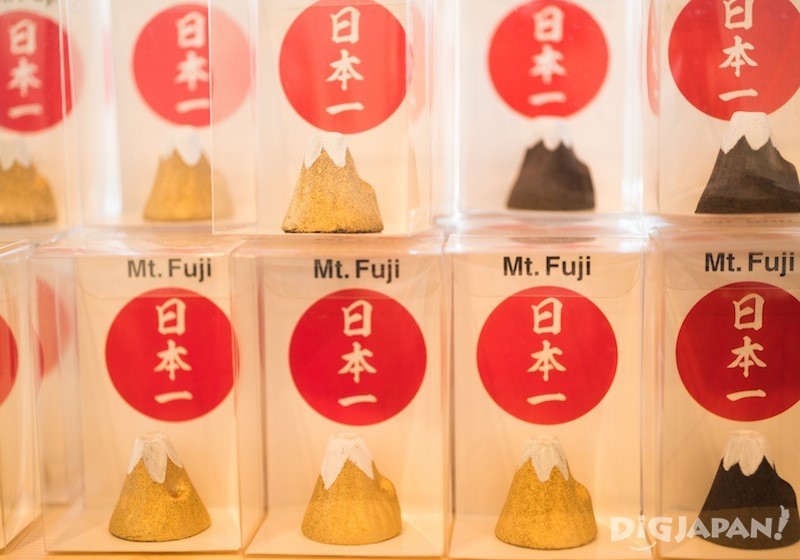
These miniature mount Fuji can fit in the palm of your hand. One piece is 500 yen. They also sell sweets and sake.
Address: 4-23 Miya-cho, Fujinomiya-shi, Shizuoka
Hours: 10:00am - 5:30pm
Access: 10 min. walk from Fujiomiya Station on the JR Minobu Line
Website (Japanese only): http://omiyayokocho.com

En-ya also serves as an art gallery. It exhibits and sells goods made by local artists and goods made using materials from Fujinomiya city.
These sake cups become mount Fuji when you put them upside down. One piece is 2,700 yen. Of course they make for perfect souvenirs, but the locals also buy them. They are unique items that can only be found here.

En-ya also collaborates with the nearby shops to offer various cultural experiences. For example, you can make traditional Japanese sweets or wear a kimono. They have guides that know the land well and will explain in English. Its is a very popular tour with foreign tourists.

Ecotour also offers a hiking tour to the Hoei Crater along with the Mt. Fuji Satoyama Village Cycling Ecotour.

En-ya helps people experience the culture and interactions with the locals that you can't get by sightseeing alone. They'll also show you the beauty of the nature surrounding Fujinomiya, the gateway to Mt. Fuji. Experience tours and ecotours start from 16,200 yen.
Address: 4-5 Miya-cho, Fujinomiya-shi, Shizuoka
Hours: 10:00am - 4:30pm
Closed on Sundays and Wednesdays
Access: 10 min. walk from Fujiomiya Station on the JR Minobu Line
Website: https://www.mtfujiecotours.com/
There is so much to see at the Mt. Fuji World Heritage Centre and the surrounding attractions. It is very easy to access from Fujinomiya station. I highly recommend it as a one-day trip from Tokyo or a 2-day trip to see some of the surrounding areas like lake Kawaguchi. Definitely consider visiting the Mt. Fuji World Heritage Centre if you are nearby!
The Heritage of Mt. Fuji Is Passed on to Future Generations at the Centre
The Mt. Fuji World Heritage Centre in Shizuoka was created to protect the history and culture of Mt. Fuji. Here, the beauty and faith that comes from nature are shown to future generations.。The exterior is uniquely shaped to resemble Mt. Fuji but upside down. Directly in front is a shallow pond filled with spring water from the mountain. The reflection of the building in the still waters sets the elegant tone that Mt. Fuji offers.

Try to visit on a clear sunny morning and you will be able to see the real Fuji together with the building.

In the atrium you can see the peculiar structure up close.

The wall of the structure is made up of almost 8,000 pieces of Fuji Hinoki, a Japanese cypress that grows at the foot of Mt. Fuji.
The pieces of cypress have been braided in a basket weave. They achieved this by the cutting the surface of the wood to give it a soft curved shape. I touched it and it was super smooth.

Walking Around the Facility Feels like You're Climbing Mt. Fuji
There are six areas in the Fuji World Heritage Centre. They are all connected by a gentle slope that wraps upward. Along the wall is a projected time-lapse video with a climber's silhouette. You will feel like you're climbing Mt. Fuji as you explore each area.This way you can enjoy the scenery from the base of the mountain all the way to the summit.
The top floor features an observatory for an even better view. Have a seat on the "Upside-down Fuji Bench" and admire Mt Fuji like a painting from this hall.

Continuing on you will find the outdoor terrace. On a day with good weather the glass doors are opened. Surrounding the terrace are brown rugged stones. These stones are made up of lava from one of Mt. Fuji's eruptions.

Learn More About Mt. Fuji from the Various Exhibits
Don't let the name fool you. Mt. Fuji is an active volcano. One of the exhibits shows its eruptive history and origin. There is also a large globe to help put Mt. Fuji and Japan into a global perspective.
This exhibit features the painting Fuji Mandala Zu. Here the religious aspects of Mt. Fuji are explained. At the top of My. Fuji is a crater called Ohachi. This crater is made up of several peaks, such as Kengamine, the tallest one. Since ancient times it is believed that Buddha appears on these peaks.
One particular exhibit focuses entirely on the shape of Mt. Fuji. The broad base wrapped with white snow has a great influence on Japanese literature and art. Large screens project paintings in their original scale.
This area shows how the rain and snow falling on Mt. Fuji become spring water. It is very fascinating to see how this process works.

While it is loved as an object of faith and art, Mt. Fuji is still an active volcano. Here you can see its many layers and the effects of the eruptions. The walls and floors were created by Mr. Shuhei Hasado, a plaster craftsman. He used ancient methods that are used for Japanese houses.

Here you can leave your own personal message on a card shaped like Mt. Fuji. Have fun looking for your message the next time you visit.

Out on the terrace you will find a Fujizuka.

A Fujizuka is typically a small pile of stones or a mound that represents Mt. Fuji. At the top of it is a shrine. These surrogates were made for pilgrims who were unable to climb the mountain. If you're not confident about climbing the real Mt. Fuji you can climb this Fujizuka instead.
The facility also has temporary exhibits, occasionally featuring paintings of Mt. Fuji and even some works that are considered national treasures. Also, at the theater is a huge 265-inch large screen (approx.. 6.7 meters). They showcase the nature of culture of Mt. Fuji in 4k high-definition. The runtime is about 7 minutes and it's shown 4 times an hour.

After Taking a Rest in the Cafeteria, Pick up a Souvenir
At the museum shop & cafe on the first floor there are goodies and snacks themed after Mt. Fuji and Shizuoka.The advisor of the museum shop is Riyo Mori, a Shizuoka native who was Miss Universe in 2007. She also designs original goods.

If you eat at the café, my food recommendation is this juicy hotdog made from Yoguru pork topped with a green tea sauce. Yoguru pigs are bred at the foot of Mt. Fuji. This is a specialty of Shizuoka and has a rich and tasty flavor.

There are also the lava ice cream (378 yen) which is ice cream sandwiched in a bun that looks like a lava stone, and Mt. Fuji-inspired soft cream (399 yen).
Information
Mt. Fuji World Heritage Centre, Shizuoka | 静岡県富士山世界遺産センターAddress: 5-12, Miya-cho, Fujinomiya-shi, Shizuoka
Hours: 9:00am - 5:00pm (6:00pm in July and August) *Entrance available until 30 minutes before closure
Closed on every third Tuesday of the month and on facility inspection days
Entrance fee: Permanent exhibit 300 yen, free for students and people 70 years or older. The fee for the temporary exhibit varies depending on the exhibit
Access: 8 min. walk from Fujiomiya Station on the JR Minobu Line. For people arriving to Shin-Fuji Station with the Tokaido Shinkansen: take the high speed bus bound for Fujisan Station and get of at the Mt. Fuji World Heritage Centre stop (36 min. bus ride).
*The high speed bus doesn't run on weekends, from December 29 to January 3, and from August 13 to 16. In those days there is also the bus bound for Kyukamura Fuji.
Website: https://mtfuji-whc.jp/en/
While You're Here, Check out These Recommended Places
Around the Mt. Fuji World Heritage Center are many spots worth stopping by. One of them is the Fujisan Hongu Sengen Taisha Shrine.
Located about 3 minutes on foot from the centre, this shrine has a history of over 2,000 years.

In front of the romon (tower gate) is a path called Sakura-no-baba, where the annual yabusame festival is held on May 4-6. Yabusame is a traditional Japanese mounted archery where you shoot a target with a bow and arrow while riding a running horse. In the grounds there is a statue of a man practicing yabusame.

Walking through the tower gate you enter the shrine grounds. The main shrine was designated as an Important Cultural Property of Japan. By the way, the Mt. Fuji World Heritage Center was built at a lower height than the main shrine so as not to look down on God.

There is a volcanic bomb, a mass of molten rock that was ejected from Mt. Fuji during an eruption on display in the shrine. You will also find a stone from the South Pole on display as well. Both are very rare and unusual.

Towards the back of the grounds is the Wakutama-ike pond. The natural spring water is crystal clear giving a beautiful reflection. You can even see the aquatic plant life and the fish swimming in the pond.

In the past, climbers of Mt. Fuji would cleanse their body in the pond's spring waters. All year round the temperature of the water is 13℃. If you touch the water of the pond it will feel cold in the summer and warm in the winter.
Right next to the pond is Mizuya Shrine. Here you can drink the spring water and even bring some home in a container.

Information
Fujisan Hongu Sengen Taisha | 富士山本宮浅間大社Address: 1-1 Miya-cho, Fujinomiya-shi, Shizuoka
Hours: 6:00am - 7:00pm from November to February / 5:30am - 7:30pm from March to October / 5:00am - 8:00pm from April to September
Access: 10 min. walk from Fujiomiya Station on the JR Minobu Line
Website: http://fuji-hongu.or.jp/sengen/english/index.html
Try the Local Specialty 'Fujinomiya Yakisoba'
In front of the Shrine is a little street called Omiya Yokocho. Here you can eat the famous Fujinomiya yakisoba and purchase souvenirs.
My attention was caught by a shop called Musubiya so I tried their Fujinomiya yakisoba. You can choose a topping of seaweed and fried eggs shaped like Mt. Fuji. You can also choose between two flavors: shio, a salt spice, and noodle sauce. I had to take a picture before eating!

The dish in the picture is called Fujiyama and it's 650 yen. 500 yen without the topping.
Musubiya also sells dango (sweet rice dumplings) and rice balls. The staff highly recommended the dumplings, saying that they are made with spring water from Mt. Fuji so I tried those as well.

The seasoning on the Fujinomiya yakisoba is original for each shop. It's fun to order a few from different places and compare.
In Omiya Yokocho there is a fountain with spring water from Mt. Fuji. You can get a paper cup at the shops and enjoy a drink. The water has a clean, natural taste. Very refreshing.

When your stomach is full, it's time to go shopping for souvenirs at Kitagawa. The most popular items in this store are calligraphy cards along with "Mini Fuji", statues made up of sand from Mt. Fuji.

You can ask the staff what's written on the cards. They are sold for 500 yen each.

These miniature mount Fuji can fit in the palm of your hand. One piece is 500 yen. They also sell sweets and sake.
Information
Omiya Yokocho | お宮横丁Address: 4-23 Miya-cho, Fujinomiya-shi, Shizuoka
Hours: 10:00am - 5:30pm
Access: 10 min. walk from Fujiomiya Station on the JR Minobu Line
Website (Japanese only): http://omiyayokocho.com
The Ecotour Office for Foreign Tourists
In the small path connecting Mt. Fuji World Heritage Centre to the shrine you will find En-ya. They mainly organize ecotours for tourists from abroad and provide sightseeing information for the surrounding areas. Look for the Information sign.
En-ya also serves as an art gallery. It exhibits and sells goods made by local artists and goods made using materials from Fujinomiya city.
These sake cups become mount Fuji when you put them upside down. One piece is 2,700 yen. Of course they make for perfect souvenirs, but the locals also buy them. They are unique items that can only be found here.

En-ya also collaborates with the nearby shops to offer various cultural experiences. For example, you can make traditional Japanese sweets or wear a kimono. They have guides that know the land well and will explain in English. Its is a very popular tour with foreign tourists.

Ecotour also offers a hiking tour to the Hoei Crater along with the Mt. Fuji Satoyama Village Cycling Ecotour.

En-ya helps people experience the culture and interactions with the locals that you can't get by sightseeing alone. They'll also show you the beauty of the nature surrounding Fujinomiya, the gateway to Mt. Fuji. Experience tours and ecotours start from 16,200 yen.
Information
En-ya | 縁やAddress: 4-5 Miya-cho, Fujinomiya-shi, Shizuoka
Hours: 10:00am - 4:30pm
Closed on Sundays and Wednesdays
Access: 10 min. walk from Fujiomiya Station on the JR Minobu Line
Website: https://www.mtfujiecotours.com/
There is so much to see at the Mt. Fuji World Heritage Centre and the surrounding attractions. It is very easy to access from Fujinomiya station. I highly recommend it as a one-day trip from Tokyo or a 2-day trip to see some of the surrounding areas like lake Kawaguchi. Definitely consider visiting the Mt. Fuji World Heritage Centre if you are nearby!

Liked this story? Like DiGJAPAN!
on Facebook for daily updates!
THIS ARTICLE IS BASED ON INFORMATION FROM 07 30,2018 Author:DiGJAPAN! Editorial Team







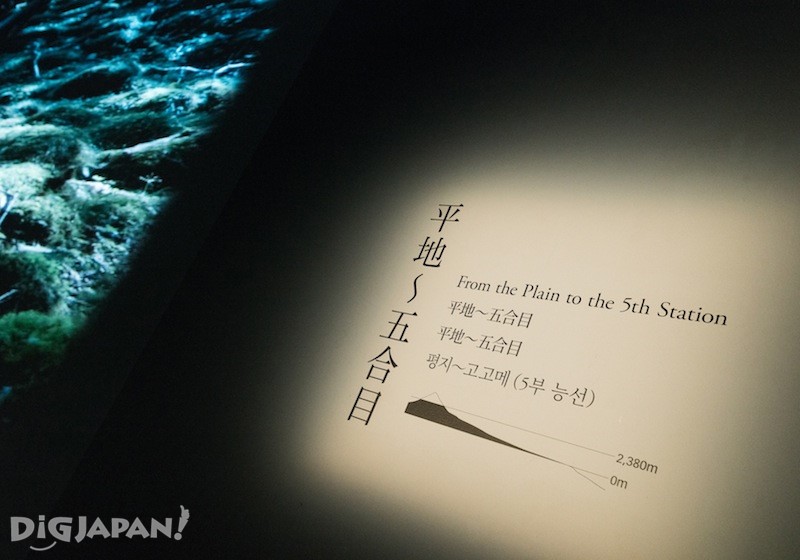

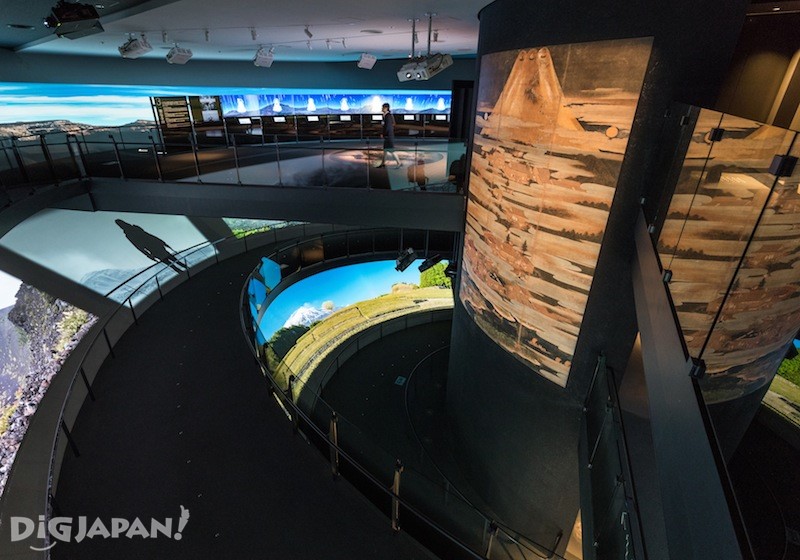







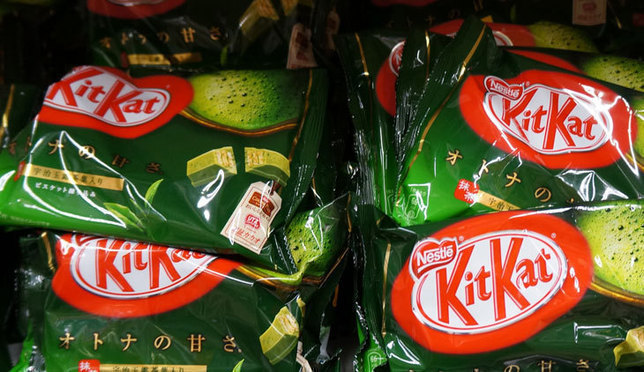


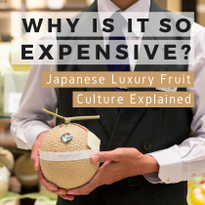





NEW COMMENT | 0 COMMENTS
Open a DiGJAPAN!
account to comment.
Open a DiGJAPAN! Account